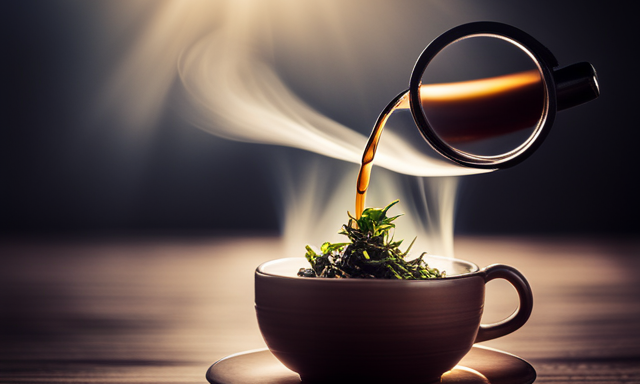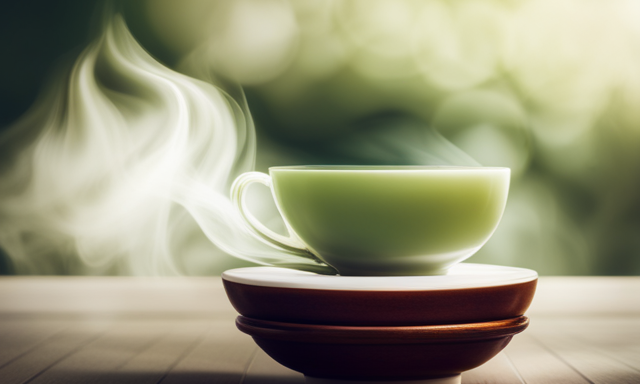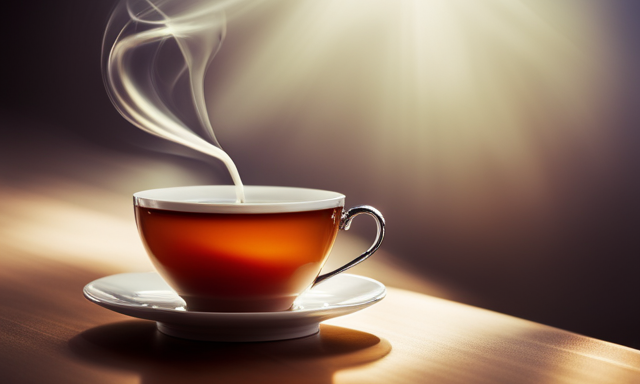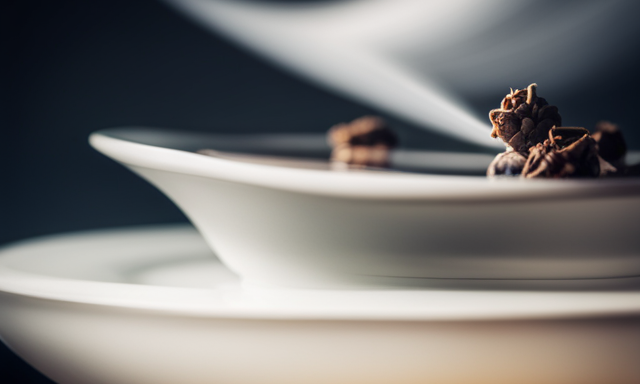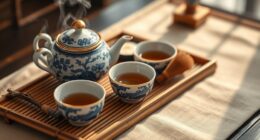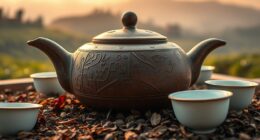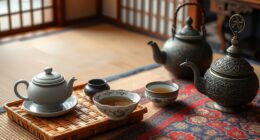As I grasp the cozy teacup in my hands, the delightful scent of oolong tea wafts through the air, immersing me in a peaceful oasis.
Have you ever wondered how long to steep oolong tea for that perfect cup? Well, look no further, because in this article, I will guide you through the art of steeping oolong tea to perfection.
Steeping time is essential when it comes to oolong tea, as it determines the flavor, strength, and complexity of the brew. With a variety of oolong teas available, each with its unique characteristics, knowing the recommended steeping times is crucial.
Whether you prefer a light or medium oolong tea, I will provide you with the precise steeping times to achieve that delightful balance of flavors.
But that’s not all – did you know that oolong tea also offers numerous health benefits? From improving heart health to enhancing mental alertness and supporting digestive health, oolong tea is a true elixir.
So, join me on this journey of discovering the art of steeping oolong tea, and let’s unlock the secrets to savoring the perfect cup every time.
Key Takeaways
- Steeping time for oolong tea can vary between 2-5 minutes.
- Different types of oolong tea have recommended steeping times for optimal flavor.
- The water temperature for steeping oolong tea varies based on the type of tea.
- Experimentation with steeping techniques and water temperatures is important to find the preferred flavor profile.
Understanding Oolong Tea: A Brief Introduction
When you steep oolong tea, you’ll watch as the leaves unfurl and release their fragrant aroma, transforming your cup into a golden elixir of warmth and tranquility.
Oolong tea has a rich history that dates back centuries, originating in China and gaining popularity worldwide. What sets oolong tea apart is its unique processing methods, which vary depending on the region and tradition. Some oolong teas are lightly oxidized, resulting in a delicate flavor profile, while others are heavily oxidized, creating a robust and complex taste.
The leaves are withered, rolled, and partially fermented to achieve the desired level of oxidation. These processing methods contribute to the diverse range of flavors found in oolong tea. Understanding the different oolong tea processing methods is essential to appreciating the nuances of each brew.
Now, let’s delve into the importance of steeping time.
The Importance of Steeping Time
Steeping oolong tea for just a brief moment is absolutely essential for unlocking its full flavor potential. The impact of steeping time on Oolong tea flavor can’t be overstated.
When brewed for too long, the delicate flavor notes can become bitter and overpowering, ruining the overall tea experience. On the other hand, steeping for too short a time may result in a weak and insipid brew.
The role of steeping time in Oolong tea’s health benefits is also significant. Proper steeping allows the leaves to release their antioxidants and polyphenols, which contribute to the tea’s potential health benefits, such as improving digestion and boosting metabolism.
As we move on to explore the different types of oolong tea and their recommended steeping times, it’s important to understand the impact of steeping time on flavor and health benefits.
Types of Oolong Tea and Their Recommended Steeping Times
Exploring the various types of oolong tea and their recommended steeping times will transport your taste buds on a flavorful journey. Oolong tea originates from China and Taiwan, where it is meticulously cultivated and processed. The tea leaves are partially oxidized, resulting in a unique flavor profile that falls somewhere between green and black tea. To fully appreciate the complexity of oolong tea, it is important to understand the different grades and their corresponding steeping times.
Here is a table that compares the grades of oolong tea and their recommended steeping times:
| Grade | Steeping Time |
|---|---|
| Light | 2-3 minutes |
| Medium | 3-4 minutes |
| Dark | 4-5 minutes |
Light oolong tea, with a steeping time of 2-3 minutes, offers a delicate and floral taste. Transitioning into the subsequent section, let’s now delve into the world of light oolong tea and discover its unique characteristics.
Light Oolong Tea: 2-3 minutes
Indulge your senses in the delicate and floral notes of light oolong tea, steeped for just 2-3 minutes, as you embark on a journey of exquisite flavors. To fully experience the subtle nuances of this tea, it’s important to pay attention to the water temperature and tea brewing techniques.
-
Water temperature: Use water that’s around 180°F (82°C) to 190°F (88°C) for light oolong tea. This allows the tea leaves to unfurl gradually, releasing their delicate aroma and flavors.
-
Tea brewing techniques: Gently place the oolong tea leaves in a teapot or infuser. Pour the hot water over the leaves and let them steep for 2-3 minutes. Avoid oversteeping, as it can result in a bitter taste.
By following these steps, you can enjoy a perfectly brewed cup of light oolong tea.
Now, let’s move on to the next section about medium oolong tea, steeped for 3-4 minutes, to explore its rich and robust flavors.
Medium Oolong Tea: 3-4 minutes
Get ready to savor the luscious flavors of medium oolong tea as it brews for 3-4 minutes, indulging your taste buds in a symphony of richness and depth.
Steeping techniques play a crucial role in achieving the optimal flavor of this tea variety. When steeped for 3-4 minutes, medium oolong tea strikes a perfect balance between the lightness of green tea and the robustness of black tea. This duration allows the leaves to unfurl and release their complex flavors, resulting in a golden-hued infusion with a smooth and slightly floral taste.
The longer steeping time compared to light oolong tea enhances the tea’s depth and body while maintaining its delicate and nuanced character.
As we move on to the next section about dark oolong tea, which requires 4-5 minutes of steeping, the flavors will deepen even further, promising an exquisite tea experience.
Dark Oolong Tea: 4-5 minutes
Brewing dark oolong tea for 4-5 minutes allows the flavors to intensify, creating a rich and aromatic infusion that will transport your taste buds to a world of indulgence.
To achieve the perfect cup of dark oolong tea, it’s essential to consider the water temperature and tea brewing techniques. Start by using water that’s heated to around 195-205°F (90-96°C). This temperature range ensures that the tea leaves release their full potential and flavors.
Next, place the dark oolong tea leaves in a teapot or infuser and pour the hot water over them. Allow the tea to steep for 4-5 minutes, allowing ample time for the flavors to fully develop. The longer steeping time allows the leaves to release their deep, complex flavors, resulting in a bold and satisfying brew.
As we move into the next section about factors that affect steeping time, it’s important to consider various elements that can impact the brewing process.
Factors That Affect Steeping Time
Immerse yourself in the world of steeping time and uncover the secrets behind the perfect cup of dark oolong tea. When it comes to steeping oolong tea, there are several factors that can affect the ideal duration.
One important factor is the water temperature. Dark oolong tea is best steeped at a temperature of around 195-205°F (90-96°C). This slightly higher temperature helps to bring out the rich flavors and aromas of the tea leaves.
Another factor to consider is the steeping vessel. Using a teapot or a gaiwan can result in a quicker infusion, while using a larger vessel like a mug may require a longer steeping time.
By balancing these factors, you can achieve the perfect cup of dark oolong tea that’s both flavorful and satisfying.
Now, let’s dive into the next section about water temperature and its impact on steeping time.
Water Temperature
As you dive into the world of steeping oolong tea, picture the impact that water temperature has on the perfect cup of dark oolong tea. The right water temperature is crucial to unlock the flavors and benefits of oolong tea.
The general rule is to use water that’s around 195°F (90°C) for steeping oolong tea. This temperature allows the leaves to unfurl slowly, releasing the complex aroma and flavors. However, it’s important to note that different oolong teas may require slightly different temperatures. Some teas may benefit from a slightly higher temperature, while others may be more delicate and require a lower temperature.
Experimenting with different tea steeping techniques and water temperatures will help you find the perfect balance for your taste preferences.
Moving on to the next section about tea leaves to water ratio, let’s explore how this factor affects the final outcome of your oolong tea.
Tea Leaves to Water Ratio
Finding the perfect balance of tea leaves to water ratio is like finding the sweet spot in a dance, where each step harmonizes with the other, creating a mesmerizing and flavorful oolong tea experience.
The amount of tea leaves used and the volume of water can greatly affect the taste and strength of the brew. Here are three brewing techniques to consider when determining the tea leaves to water ratio for oolong tea:
- Light brew: Use 1 teaspoon of tea leaves per 8 ounces of water for a delicate and subtle flavor.
- Medium brew: Use 1.5 teaspoons of tea leaves per 8 ounces of water for a balanced and aromatic brew.
- Strong brew: Use 2 teaspoons of tea leaves per 8 ounces of water for a robust and intense flavor.
By adjusting the tea leaves to water ratio, you can experiment with steeping time variations to further customize your oolong tea experience.
Now, let’s explore the next aspect of brewing oolong tea: the teapot or infuser type.
Teapot or Infuser Type
Choose the perfect teapot or infuser type to enhance your oolong tea brewing experience. When it comes to steeping oolong tea, the right equipment can make all the difference. There are various teapot options to choose from, each offering its own unique benefits. For a traditional brewing experience, a clay teapot is ideal as it helps to enhance the tea’s flavor and aroma. If you prefer convenience, a glass teapot allows you to watch the leaves unfurl and enjoy the visual aspect of tea brewing. Alternatively, an infuser basket or ball is a practical choice for single servings or when you’re on the go. Whichever option you choose, make sure it has enough space for the tea leaves to fully expand and release their flavors. Now, let’s move on to the next section and explore how to steep oolong tea step-by-step.
How to Steep Oolong Tea: Step-by-Step Guide
Prepare to embark on a journey of flavor as you unleash the full potential of your oolong tea through the art of steeping. Experimenting with steeping time is key to achieving the right flavor profile for your oolong tea. Here’s a step-by-step guide to help you master the art of steeping oolong tea:
-
Start by heating your water to the appropriate temperature, which can vary depending on the type of oolong tea you’re using.
-
Measure out the desired amount of oolong tea leaves and place them in a teapot or infuser.
-
Pour the heated water over the tea leaves and let them steep for 2-3 minutes for a lighter flavor, or 4-5 minutes for a bolder taste.
-
Once the desired steeping time has elapsed, remove the tea leaves and enjoy your perfectly steeped oolong tea.
Now that you know how to steep oolong tea, let’s move on to preparing the water for the ultimate tea experience.
Preparing the Water
Boil the water to the appropriate temperature to ensure a perfect infusion of flavors in your oolong tea. The water temperature plays a crucial role in extracting the delicate aromas and flavors from the tea leaves.
Oolong tea is best steeped using water that’s around 190-200 degrees Fahrenheit (88-93 degrees Celsius). This temperature range allows for the optimal release of the tea’s complex flavors without scorching the leaves.
To achieve the right water temperature, you can either use a thermometer or simply bring the water to a boil and let it cool for a few minutes.
Once the water is at the correct temperature, it’s time to move on to measuring the tea leaves and starting the steeping process.
Measuring the Tea Leaves
Now, let’s get started by measuring out the perfect amount of tea leaves for a truly delightful cup of oolong. Measuring accuracy is crucial when it comes to tea brewing techniques, as it ensures the right balance of flavors and aromas.
For oolong tea, the general rule is to use approximately 2 grams of tea leaves per 8 ounces of water. However, this can be adjusted based on personal preference. To achieve the desired strength, you can increase or decrease the amount of tea leaves accordingly.
Using a scale or a teaspoon can help with the accuracy of measurement. Once you have measured the tea leaves, you’re ready to move on to the next step of steeping the tea, where the magic truly happens.
Steeping the Tea
To create the perfect cup of oolong tea, all you need to do is let the tea leaves dance in hot water, releasing their intricate flavors and captivating aromas.
Here’s how to steep oolong tea like a pro:
-
Water temperature: Oolong tea is best steeped in water that’s around 190-200°F (88-93°C). This temperature range allows the leaves to unfurl and infuse the water with their unique characteristics.
-
Brewing equipment: Use a teapot or a tea infuser to steep oolong tea. These tools let the leaves expand and release their flavors evenly.
-
Steeping time: Depending on the type of oolong tea, the steeping time can vary between 2-5 minutes. It’s important to follow the specific instructions for the particular oolong tea you’re using to achieve the desired taste.
Once the steeping is complete, it’s time to strain and enjoy the delightful flavors of oolong tea.
Straining and Enjoying
Once the tea’s steeped to perfection, it’s time to strain and savor the delightful flavors of your oolong brew.
To strain the tea, use a fine mesh strainer or a tea infuser that allows the liquid to flow through while capturing the tea leaves. This’ll ensure a smooth and enjoyable drinking experience, free from any residue.
As for pairing oolong tea with food, its complex and floral notes make it a versatile choice. It pairs well with lightly flavored foods like seafood, salads, and light desserts. The subtle sweetness and earthy undertones of oolong tea complement the flavors of these dishes, enhancing the overall dining experience.
Now, let’s move on to the next section where we’ll explore experimenting with steeping time to find your perfect brew.
Experimenting with Steeping Time: Finding Your Perfect Brew
When experimenting with steeping time, finding the perfect brew can result in a richer and more flavorful cup of tea, according to a study conducted by tea enthusiasts.
To find the ideal steeping time for oolong tea, it’s recommended to experiment with different tea to water ratios. Start by using a ratio of one teaspoon of tea per cup of water and steep for three minutes. Then, adjust the steeping time by adding or subtracting 30 seconds to find your preferred flavor profile. This process allows you to customize your tea to suit your taste preferences.
By experimenting with steeping time, you can unlock the full potential of the tea leaves and discover a brew that’s perfectly suited to you.
Moving on to common mistakes to avoid, it’s important to pay attention to water temperature and avoid oversteeping.
Common Mistakes to Avoid
When it comes to experimenting with steeping time for oolong tea, it’s important to be aware of common mistakes that can affect the accuracy of your brew.
One common mistake is not paying attention to the recommended steeping time for the specific type of oolong tea you’re using. Each type of oolong tea has its own unique characteristics and flavors, which require different steeping times to fully develop.
Steeping for too short a time can result in a weak and flavorless cup, while steeping for too long can lead to a bitter and astringent taste. It’s crucial to find the right balance and adhere to the recommended steeping time to achieve the desired flavor profile.
By avoiding these common mistakes, you can ensure that your oolong tea is steeped to perfection.
Now, let’s move on to some additional tips for brewing the best oolong tea.
Additional Tips for Brewing the Best Oolong Tea
To truly elevate your oolong tea experience, these extra tips will ensure a brew that tantalizes your taste buds. When it comes to brewing techniques, oolong tea leaves are delicate and require special attention.
Start by using freshly boiled water, around 180-190°F, to steep the leaves. This temperature will bring out the best flavor without scorching the leaves. Depending on the specific oolong tea you have, steeping times can vary. Generally, you’ll want to steep oolong tea for 3-5 minutes, but some teas may require longer or shorter steeping times. This will allow the flavors to fully develop, resulting in a well-rounded brew. Experiment with different steeping times to find your preferred flavor profile.
As we move into the next section about using high-quality tea leaves, let’s explore how the quality of the leaves can influence the taste of your oolong tea.
Using High-Quality Tea Leaves
Using high-quality tea leaves is essential for achieving the best flavor and aroma in your oolong tea. When it comes to tea steeping techniques, selecting the right oolong tea is crucial. Here are three reasons why using high-quality tea leaves is worth it:
-
Superior Taste: High-quality oolong tea leaves are carefully cultivated and processed, resulting in a rich and complex flavor profile that elevates your tea-drinking experience.
-
Aromatic Delight: The aroma of high-quality oolong tea leaves is enchanting, with delicate floral or fruity notes that awaken your senses and make each sip a pleasure.
-
Health Benefits: Premium oolong tea leaves contain higher levels of antioxidants and beneficial compounds, promoting overall well-being.
Now that you know the importance of using high-quality tea leaves, let’s explore the next step: proper storage of oolong tea.
Proper Storage of Oolong Tea
Storing your premium oolong tea properly ensures that its flavors and aromas remain intact, providing you with a delightful tea-drinking experience. Proper storage is crucial in prolonging the freshness of your oolong tea. Here are some essential tips to help you keep your tea at its best:
| Temperature | Humidity | Container |
|---|---|---|
| Cool | Dry | Airtight |
| 50-80°F | 50-70% | Tin or ceramic |
Maintaining a cool and dry environment is essential to prevent moisture and heat from degrading the quality of your oolong tea. Storing it in an airtight container, such as a tin or ceramic jar, helps to keep out light and air, which can also affect its freshness. By following these proper storage techniques, you can ensure that your oolong tea retains its vibrant flavors and delicate aromas for a longer period. Now, let’s delve into exploring different flavor profiles of oolong tea.
Exploring Different Flavor Profiles
Indulge in a symphony of tantalizing taste notes as you journey through the diverse flavor profiles of oolong tea. Explore brewing techniques and compare different oolong tea varieties to discover a world of flavors that’ll captivate your taste buds. Here are five bullet points to entice your senses:
- Experience the delicate floral aroma and smooth, buttery taste of a lightly oxidized oolong.
- Savor the rich, roasted flavor and caramel undertones of a heavily oxidized oolong.
- Enjoy the refreshing, fruity notes of a green oolong with its vibrant infusion.
- Delight in the complex, honey-like sweetness of a pouchong oolong.
- Revel in the unique, nutty and earthy flavors of a dark oolong.
As you explore these flavor profiles, you’ll be amazed by the depth and complexity of oolong tea.
Transitioning into the subsequent section about the health benefits of oolong tea, let’s now delve into how this tea can positively impact your well-being.
Health Benefits of Oolong Tea
Immerse yourself in a world of wellness and discover how oolong tea can enhance your overall health and vitality. Oolong tea is not only a delicious beverage, but it also offers numerous health benefits.
One of the key advantages of oolong tea is its ability to boost immunity. Packed with antioxidants, oolong tea helps strengthen the immune system, making it more resistant to infections and diseases.
Additionally, oolong tea has been found to reduce inflammation in the body. By fighting inflammation, oolong tea can help alleviate symptoms of chronic conditions such as arthritis and heart disease.
Transitioning into the subsequent section about ‘boosts metabolism and weight loss’, oolong tea offers even more benefits for your well-being.
Boosts Metabolism and Weight Loss
After learning about the numerous health benefits of oolong tea, let’s dive into how it can help boost metabolism and aid in weight loss. As an avid tea drinker, I can attest to the positive effects it has on my energy levels.
Oolong tea contains caffeine and other compounds that stimulate the central nervous system, increasing metabolism and promoting fat oxidation. Additionally, its anti-inflammatory properties help reduce inflammation in the body, which can be beneficial for weight loss.
To fully understand the potential of oolong tea for boosting metabolism and aiding in weight loss, consider the following:
-
Oolong tea increases calorie burning by up to 10%, helping you shed those extra pounds.
-
It promotes fat breakdown by activating enzymes that break down stored fat.
-
Oolong tea can suppress appetite and reduce cravings, making it easier to stick to a healthy diet.
As we delve into the next section on how oolong tea improves heart health, it’s important to note that every sip brings us closer to a healthier lifestyle.
Improves Heart Health
Improving heart health, oolong tea can enhance cardiovascular function and reduce the risk of heart disease. With its rich antioxidant content, oolong tea helps to prevent heart disease by reducing the levels of bad cholesterol and promoting the production of good cholesterol. The polyphenols found in oolong tea also have anti-inflammatory properties, which can help to improve blood flow and reduce the risk of blood clots. Additionally, oolong tea contains catechins, which are known to have a protective effect on the heart.
By regularly consuming oolong tea, you can reap the cardiovascular health benefits it offers, promoting a healthier heart and reducing the risk of heart disease.
Transitioning into the next section, oolong tea not only enhances heart health but also enhances mental alertness.
Enhances Mental Alertness
Boosting mental alertness, oolong tea is packed with antioxidants that can help sharpen your focus and keep you mentally sharp throughout the day. The combination of caffeine and L-theanine in oolong tea improves focus and increases concentration. The stimulating effects of caffeine can enhance cognitive function, while L-theanine promotes relaxation and reduces anxiety, allowing for improved mental clarity. To further illustrate the benefits of oolong tea for mental alertness, consider the following table:
| Antioxidants | Improves Focus | Increases Concentration |
|---|---|---|
| EGCG | ✔️ | ✔️ |
| Theaflavins | ✔️ | ✔️ |
| Caffeine | ✔️ | ✔️ |
These antioxidant compounds found in oolong tea support brain health and enhance mental performance. Moving forward to the next section about supporting digestive health, oolong tea also provides numerous benefits for a healthy gut.
Supports Digestive Health
To support your digestive health, oolong tea offers a range of benefits that can help improve gut function and promote overall wellness. Here are four ways in which oolong tea supports your digestive system and enhances gut health:
-
Reduces inflammation: Oolong tea contains polyphenols that possess anti-inflammatory properties. Consuming oolong tea regularly can help reduce inflammation in the digestive tract, easing discomfort and promoting a healthy gut.
-
Boosts metabolism: Oolong tea contains catechins and caffeine, which can increase metabolism and aid in digestion. This can help prevent bloating and improve the overall efficiency of your digestive system.
-
Enhances nutrient absorption: The antioxidants in oolong tea can improve nutrient absorption in the gut, ensuring that your body gets the maximum benefit from the food you consume.
-
Supports healthy gut bacteria: Oolong tea acts as a prebiotic, providing nourishment to the beneficial bacteria in your gut. This helps maintain a healthy balance of gut flora, which is essential for optimal digestive health.
By incorporating oolong tea into your daily routine, you can support your digestive system and enjoy the many benefits it offers. Transitioning to the next section, let’s explore the art of savoring the perfect cup of oolong tea.
Conclusion: Savoring the Perfect Cup of Oolong Tea
Indulge in the art of relishing the perfect cup of oolong tea, allowing yourself to savor every sip and experience the true essence of this exquisite beverage. When it comes to steeping oolong tea, finding the right steeping time is crucial to unlocking its full flavor potential. The general guideline is to steep oolong tea for 3-5 minutes. However, this can vary depending on personal preference and the specific type of oolong tea. Experimenting with different tea to water ratios can also enhance your tea-drinking experience. Some oolong tea enthusiasts prefer a stronger flavor and opt for a higher tea to water ratio, while others prefer a more delicate taste and use less tea leaves. Remember, the perfect cup of oolong tea is a personal journey, so take the time to explore and discover your own preferred steeping time and tea to water ratio. Cheers to a delightful tea-drinking experience!
| Steeping Time | Tea to Water Ratio | Flavor |
|---|---|---|
| 3-5 minutes | 1 teaspoon : 8 oz | Robust |
| 2-3 minutes | 1 teaspoon : 12 oz | Delicate |
| 5-7 minutes | 1 teaspoon : 6 oz | Strong |
| 4-6 minutes | 1 teaspoon : 10 oz | Balanced |
Frequently Asked Questions
What are some common mistakes to avoid when steeping oolong tea?
When steeping oolong tea, avoid common mistakes like using water that is too hot or steeping for too long. To achieve perfect oolong tea, follow these tips for precise steeping.
How should I store oolong tea to maintain its freshness?
To maintain the freshness of oolong tea, store it in an airtight container away from light, heat, and moisture. Properly stored, oolong tea can have a shelf life of up to two years.
Can I steep oolong tea for longer than the recommended time to make it stronger?
Steeping oolong tea for longer than recommended can intensify its flavor, but be cautious. Excessive steeping time can lead to a bitter taste and overpowering aroma. Experiment to find your desired strength without compromising taste.
Are there any potential side effects or risks associated with drinking oolong tea?
Drinking oolong tea in moderation offers potential health benefits. However, exceeding the recommended daily intake may lead to side effects such as caffeine sensitivity, digestive issues, and even increased risk of kidney stones.
Can oolong tea be enjoyed with milk or sweeteners, or is it best to drink it plain?
Yes, oolong tea can be enjoyed with milk or sweeteners, depending on personal preference. The addition of milk can create a creamy and smooth flavor, while sweeteners enhance the natural sweetness.
Conclusion
In conclusion, steeping oolong tea for the right amount of time is crucial to fully appreciate its flavors and benefits. Remember, patience’s a virtue when it comes to brewing the perfect cup. As the old saying goes, "Good things come to those who wait." So take your time, let the tea leaves dance in hot water, and savor every sip.
By doing so, you’ll not only enjoy a delicious cup of oolong tea, but also reap its numerous health benefits. Cheers to a delightful tea experience!

